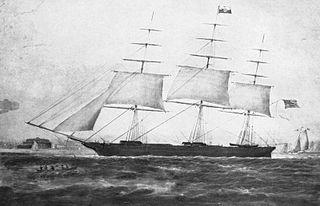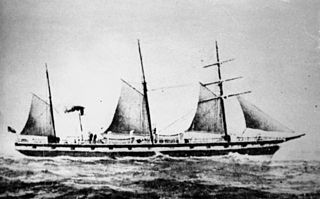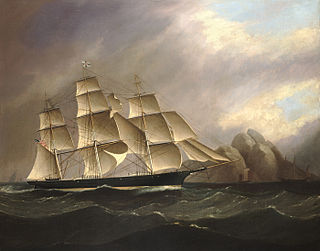
Cutty Sark is a British clipper ship. Built on the River Leven, Dumbarton, Scotland in 1869 for the Jock Willis Shipping Line, she was one of the last tea clippers to be built and one of the fastest, coming at the end of a long period of design development for this type of vessel, which halted as steamships took over their routes. She was named after the short shirt of the fictional witch in Robert Burns' poem Tam o' Shanter, first published in 1791.

Champion of the Seas was the second largest clipper ship destined for the Liverpool, England - Melbourne, Australia passenger service. Champion was ordered by James Baines of the Black Ball Line from Donald McKay. She was launched 19 April 1854 and was abandoned 3 January 1877, off Cape Horn.

City of Adelaide is a clipper ship, built in Sunderland, England, and launched on 7 May 1864. It was built by Pile, Hay and Co. to transport passengers and goods between Britain and Australia. Between 1864 and 1887 she made 23 annual return voyages from London and Plymouth to Adelaide, South Australia and played an important part in the immigration of Australia. On the return voyages she carried passengers, wool, and copper from Adelaide and Port Augusta to London. From 1869 to 1885 she was part of Harrold Brothers' "Adelaide Line" of clippers.

Lammermuir was an extreme clipper ship built in 1864 by Pile, Spence and Company of West Hartlepool for John "Jock" "White Hat" Willis & Son, London. She was the second ship to bear the name. The first Lammermuir had been the favorite ship of John Willis, and was wrecked in the Gaspar Strait in 1863.

USS Nightingale was originally the tea clipper and slave ship Nightingale, launched in 1851. USS Saratoga captured her off Africa in 1861; the United States Navy then purchased her.

SS Gothenburg was an iron-hulled sail- and steamship that was built in England in 1854 and sailed between England and Sweden until 1862. She then moved to Australia, where she operated across the Tasman Sea to and from New Zealand until 1873, when she was rebuilt. After her rebuild, she operated in the Australian coastal trade.

Loch Vennachar was an iron-hulled, three-masted clipper ship that was built in Scotland in 1875 and lost with all hands off the coast of South Australia in 1905. She spent her entire career with the Glasgow Shipping Company, trading between Britain and Australia. The company was familiarly called the "Loch Line", as all of its ships were named after Scottish lochs. The ship was named after Loch Venachar, in what was then Perthshire.

Ocean Telegraph was a clipper ship that was built in Massachusetts in 1854 and was last known of in Gibraltar in 1923. She was in US ownership until 1863, when UK interests bought her and renamed her Light Brigade.

HMAS Grantala was a passenger steamship that was built in England in 1903 as a coastal interstate liner for the Adelaide Steamship Company. In 1914 the Commonwealth government requisitioned her as a Royal Australian Navy hospital ship.

Rodney was an iron-hulled clipper ship that was built in Sunderland in 1874 and wrecked on the Cornish coast in 1901. She was one of the last ships built for the Australian migration trade. Devitt and Moore operated her between Britain and Australia for more than two decades. Rodney set numerous records for speed, and had luxuries that were unusual for her era.
Joseph Conrad was a Polish author who wrote in English after settling in England. He is regarded as one of the greatest writers in English, though he did not speak the language fluently until he was in his twenties, and always with a marked Polish accent. Before embarking on writing, he had a career sailing in the French, then the British, merchant marine. Of his 19-year merchant-marine career, about half that time was spent actually at sea.

The Murray was a three-masted clipper ship that was built in Scotland in 1861 and lost off the coast of Sweden in 1884. For nearly 20 years the Orient Line sailed between London and South Australia. In 1880 Norwegian owners bought her and renamed her Freia.

Hesperus was an iron-hulled, three-masted, passenger clipper ship that was built in Scotland in 1874 and scrapped in Italy in 1923. She was built for Thompson and Anderson's Orient Line service between Great Britain and South Australia.

Yatala was a British clipper ship that was built in England in 1865 and wrecked on the north coast of France in 1872. She spent her seven-year career with Anderson, Thomson and Co's Orient Line, sailing between London and South Australia.

South Australian was a composite-hulled clipper ship that was built in Sunderland in 1868 and sank in the Bristol Channel in 1889. She was a successor to clippers St Vincent and City of Adelaide. For nearly two decades she voyaged annually between London and South Australia.

Coonatto, was a British three-masted clipper that was built in 1863 and wrecked in 1876. She traded between London and Adelaide for 12 years. She was wrecked in the English Channel in February 1876.
St Vincent was a three-masted sailing ship that was built in England in 1865, renamed Axel in 1894 and scrapped in 1907. For the first part of her career she was a clipper, trading between London and Adelaide. She was later re-rigged as a barque, and spent the final part of her career she was under Norwegian ownership.

The New Zealand Company was a 19th-century English company that played a key role in the colonisation of New Zealand. The company was formed to carry out the principles of systematic colonisation devised by Edward Gibbon Wakefield, who envisaged the creation of a new-model English society in the southern hemisphere. Under Wakefield's model, the colony would attract capitalists who would then have a ready supply of labour—migrant labourers who could not initially afford to be property owners, but who would have the expectation of one day buying land with their savings.

Donald McKay, named after her designer, was built for James Baines & Co. She was the last extreme clipper ship built by Donald McKay. Donald McKay sailed on the Black Ball Line of Liverpool from 1855 to 1868, carrying passengers and mail between England and Australia.
Lalla Rookh was a square-rigged, iron-hulled tea clipper of 869 tons, built in 1856 in Liverpool, Lancashire, owned by William Prowse & Co. and said to travel fast. She was used for trade with India and China, and was advertised in 1871 as a packet ship to take passengers to Australia. She was completely wrecked at Prawle Point, Devon on 3 March 1873, with the loss of one crew member and all of her cargo of tea and tobacco.



















